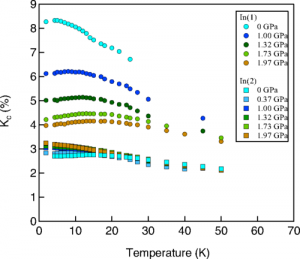Electronic Behavior at High Pressure
Recently our group has published two new studies on the behavior of heavy fermion materials under hydrostatic pressure. Jim Lin synthesized crystals and measured the Knight shift in CeRhIn5 in a 12 T field at pressures up to 2.5 GPa (25,000 atm). At these pressures, the atoms in the lattice move closer together (the lattice spacing reduced by about a percent), and the electronic orbitals can change char

acter. Indeed, this material exhibits a change in the Fermi surface around 2GPa, reflecting the fact that the Ce 4f electrons become itinerant. Jim’s results indicate a dramatic change in the coupling between the nuclei and the electronic environment at these pressure. Specifically, he found that the hyperfine coupling and the electric field gradient at the In(1) site change under pressure. This is the first study where hyperfine couplings have been observed to be pressure dependent, and offer a new window to study the subtle changes to the electronic system at a quantum phase transition. This work was published in Phys. Rev B.

In a parallel study, Kent Shirer and collaborators have investigated the behavior in the heavy fermion material URu2Si2 under pressure. This fascinating material exhibits a thermodynamic phase transition to an ordered phase at low temperature, but the nature of this so-called ‘hidden order’ phase has remained unknown for nearly three decades. Our work has focused on the behavior of the Knight shift and the spin lattice relaxation rate as a function of pressure in the paramagnetic phase above the hidden order temperature to study how the fluctuations change. Pressure suppressed the hidden order phase, and stabilizes an antiferromagnetic order. This material presents significant experimental challenges, because the Si-29 isotope used in our studies has a low natural abundance. As a result, the signal is reduced in intensity, in crystals that are already less then a mm in size. The width of the coil in the figure at right is on the order of 1 mm.
